 W
WThe Tank, Cruiser, Challenger (A30) was a British tank of World War II. It mounted the QF 17-pounder anti-tank gun on a chassis derived from the Cromwell tank to add anti-tank firepower to the cruiser tank units. The design compromises made in fitting the large gun onto the Cromwell chassis resulted in a tank with a powerful weapon and reduced armour. The extemporised 17-pounder Sherman Firefly conversion of the US-supplied Sherman was easier to produce and, with delays in production, only 200 Challengers were built. The Challenger was able to keep up with the fast Cromwell tank and was used with them.
 W
WThe Bishop was a British self-propelled artillery vehicle based on the Valentine tank and armed with the 25 pounder gun-howitzer, which could fire an 87.6 mm (3.45 in) 11.5 kg (25 lb) HE shell or an armour-piercing shell. A result of a rushed attempt to create a self-propelled gun, the vehicle had numerous problems, was produced in limited numbers and was soon replaced by better designs.
 W
WThe Canon de 194 GPF - was the first French tracked self-propelled gun (SPG). Designed at the end of World War I, it was a pioneering weapon with many modern features.
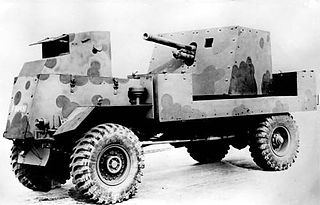 W
WThe AEC Mk I Gun Carrier, known as Deacon, was a British armoured fighting vehicle of the Second World War. It was an attempt to make the QF 6 pounder anti-tank gun into a self-propelled artillery piece. It was employed only during the North African Campaign from 1942 to 1943.
 W
WThe 75 mm Howitzer Motor Carriage M8 was a self-propelled howitzer vehicle of the United States in use during World War II. It was developed on the chassis of the M5 Stuart tank and was equipped with a M116 howitzer in an M7 mount.
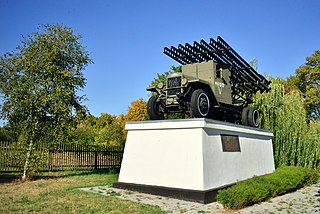 W
WThe Katyusha multiple rocket launcher is a type of rocket artillery first built and fielded by the Soviet Union in World War II. Multiple rocket launchers such as these deliver explosives to a target area more quickly than conventional artillery, but with lower accuracy and requiring a longer time to reload. They are fragile compared to artillery guns, but are cheap, easy to produce, and usable on any chassis. The Katyushas of World War II, the first self-propelled artillery mass-produced by the Soviet Union, were usually mounted on ordinary trucks. This mobility gave the Katyusha, and other self-propelled artillery, another advantage: being able to deliver a large blow all at once, and then move before being located and attacked with counter-battery fire.
 W
WThe Kliment Voroshilov (KV) tanks are a series of Soviet heavy tanks named after the Soviet defence commissar and politician Kliment Voroshilov who operated with the Red Army during World War II. The KV tanks were known for their heavy armour protection during the early stages of the war, especially during the first year of the German invasion of the Soviet Union. In certain situations, even a single KV-1 or KV-2 supported by infantry could halt German formations. The German Wehrmacht at that time rarely deployed its tanks against KVs, as their own armament was too poor to deal with the "Russischer Koloss" – "Russian Colossus".
 W
WThe Kliment Voroshilov (KV) tanks are a series of Soviet heavy tanks named after the Soviet defence commissar and politician Kliment Voroshilov who operated with the Red Army during World War II. The KV tanks were known for their heavy armour protection during the early stages of the war, especially during the first year of the German invasion of the Soviet Union. In certain situations, even a single KV-1 or KV-2 supported by infantry could halt German formations. The German Wehrmacht at that time rarely deployed its tanks against KVs, as their own armament was too poor to deal with the "Russischer Koloss" – "Russian Colossus".
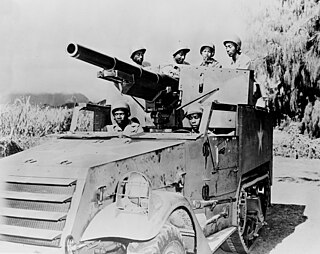 W
WThe M3 Gun Motor Carriage (GMC) was a United States Army tank destroyer equipped with a 75 mm M1897A4 gun, which was built by the Autocar Company during World War II.
 W
WThe 105 mm Howitzer Motor Carriage M7 was an American self-propelled artillery vehicle produced during World War II. It was given the official service name 105 mm Self Propelled Gun, Priest by the British Army, due to the pulpit-like machine gun ring, and following on from the Bishop and the contemporary Deacon self-propelled guns.
 W
WThe 155 mm Gun Motor Carriage M12 was a U.S. self-propelled gun developed during the Second World War. It mounted a 155 mm gun derived from the French Canon de 155mm GPF field gun.
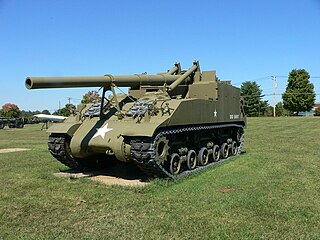 W
WThe 155 mm Gun Motor Carriage M40 was an American self-propelled artillery vehicle built on a widened and lengthened Medium Tank M4A3 chassis, but with a Continental engine and with HVSS, which was introduced at the end of the Second World War.
 W
WThe 155 mm Howitzer Motor Carriage M41 was an American self-propelled artillery vehicle built on a lengthened M24 Chaffee tank chassis that was introduced at the end of the Second World War. Out of a planned run of 250, only 85 were produced before cancellation of the order at the end of 1945. The M41 went on to serve extensively in the Korean War, its success influencing the design of later U.S. self-propelled artillery. The type was retired after the conclusion of that conflict, but went on to serve briefly in the French Army.
 W
WThe 203 mm Howitzer Motor Carriage M43 was an American self-propelled artillery vehicle built on a widened and lengthened Medium Tank M4A3 chassis, but with a Continental engine and HVSS that was introduced at the end of the Second World War. The M43 shared the same chassis as the more widely produced M40 Gun Motor Carriage, which instead mounted a 155 mm gun, and were designed by the Pressed Steel Car Company. A production run of 576 was planned originally, but in the end only 24 were produced and another 24 were converted from M40 hulls. The M43 went on to serve in the Korean War, and was retired after its conclusion.
 W
WThe 25pdr SP, tracked, Sexton was a Canadian-designed self-propelled artillery vehicle of the Second World War. It was based on Canadian-built derivatives of the American M3 Lee and M4 Sherman tank chassis. Canada had setup to produce the Ram tank using the M3 chassis and Grizzly to complement US medium tank production; when Sherman production in the US expanded and supply was no longer a problem, it was decided in 1943 to switch the Canadian production lines to produce the Sexton to give the British Army a mobile artillery gun using their 87.6 mm (3.45 in) Ordnance QF 25 pounder gun-howitzer for commonality with towed guns. The Sexton could fire either HE shell or an armour-piercing shell. It found use in the Canadian and British Army, as well as numerous other British Empire and associated forces. Just after the war, a number of Grizzly and Sextons were sold to Portugal, who used them into the 1980s.
 W
WThe SU-14 was a prototype Soviet heavy self-propelled gun built on a T-35 chassis. The original prototype mounted a 152 mm gun M1935 (Br-2); the SU-14-1 variant of 1936 carried a 203 mm gun B-4 which could fire 48.9 kilogram shells at ranges up to 25 km. Its armour was 20 to 50 mm thick. It never entered serial production.
 W
WThe SU-85 was a Soviet self-propelled gun used during World War II, based on the chassis of the T-34 medium tank. Earlier Soviet self-propelled guns were meant to serve as either assault guns, such as the SU-122, or as tank destroyers; the SU-85 fell into the latter category. The designation "85" means the bore of the vehicle's armament, the 85 mm D-5S gun.
 W
WThe SU-100 was a Soviet tank destroyer armed with a 100 mm anti-tank gun in a casemate superstructure. It was used extensively during the last year of World War II and saw service for many years afterwards with the armies of Soviet allies around the world.
 W
WThe SU-100Y was a Soviet prototype self-propelled gun, developed from the prototype T-100 tank. It was developed during the Winter War with Finland to include a 130 mm gun to destroy concrete defensive structures like bunkers and anti-tank obstacles. It did not see production, but the prototype was brought into use in the Second World War in defence of Moscow.
 W
WThe T19 Howitzer Motor Carriage (HMC) was a 105 mm (4.1 in) howitzer mounted on a M3 Half-track chassis. It saw service during World War II with the U.S. Army. Its secondary armament consisted of an air-cooled .50 in (13 mm) M2 machine gun for local defense. It was produced by Diamond T between January 1942 and April 1942.
 W
WThe T30 Howitzer Motor Carriage (HMC) was a United States Army self-propelled gun used in World War II. Its design was based on requirements for an assault gun issued by the Armored Force in 1941 and it was built as an interim solution until a fully tracked design was complete.
 W
WThe Rocket Launcher T34 (Calliope) was a tank-mounted multiple rocket launcher used by the United States Army during World War II. The launcher was placed atop the M4 Sherman, with its prominent vertical side frames anchored to the turret's sides, and fired a barrage of 4.5 in (114 mm) M8 rockets from 60 launch tubes. It was developed in 1943; small numbers were produced and were used by various US armor units in 1944–45. It adopts its name from the musical instrument "Calliope", also known as the steam organ, which had similar parallel or clustered pipes.
 W
WThe Rocket Launcher T40/M17 (Whizbang) was a tank-mounted multiple rocket launcher used by the United States Army during World War II. The launcher was placed atop the Medium Tank M4, and fired a barrage of 7.2 in (180 mm) T37 HE or T21 Chemical rockets from 20 launch tubes. It was developed and used in the late stages of World War II; it saw limited combat in 1944–45. An experimental short variant of the T40 was also developed.
 W
WThe 240 mm Howitzer Motor Carriage T92 was a self-propelled howitzer developed by the United States during World War II. The same mounting with the 8-inch Gun M1 was developed as the T93. Neither was built in significant numbers and the war ended before they could be used in combat.
 W
WThe Type 1 Gun tank Ho-Ni I was a tank destroyer and self-propelled artillery developed by the Imperial Japanese Army for use during World War II in the Pacific theater. It saw limited combat action, being first deployed at the Battle of Luzon in the Philippines in 1945. There were two variant models known as the Ho-Ni II and Ho-Ni III. All three types were only produced in limited numbers.
 W
WThe Type 3 Gun tank Ho-Ni III was a tank destroyer and self-propelled artillery of Imperial Japanese Army in World War II. The Type 3 Ho-Ni III superseded the Type 1 Ho-Ni I and its variant the Type 1 Ho-Ni II in production, and gave better protection to the crew by having a completely enclosed superstructure.
 W
WThe Type 4 Ha-To was a self-propelled gun developed by the Imperial Japanese Army for use in World War II.
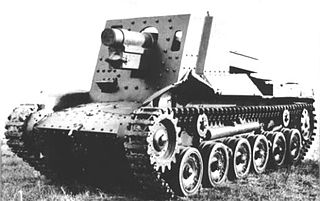 W
WThe Type 4 15cm self-propelled gun Ho-Ro was based on an already existing reinforced Type 97 Chi-Ha medium tank chassis developed by the Imperial Japanese Army in World War II.
 W
WThe Kliment Voroshilov (KV) tanks are a series of Soviet heavy tanks named after the Soviet defence commissar and politician Kliment Voroshilov who operated with the Red Army during World War II. The KV tanks were known for their heavy armour protection during the early stages of the war, especially during the first year of the German invasion of the Soviet Union. In certain situations, even a single KV-1 or KV-2 supported by infantry could halt German formations. The German Wehrmacht at that time rarely deployed its tanks against KVs, as their own armament was too poor to deal with the "Russischer Koloss" – "Russian Colossus".
 W
WThe Uralmash-1 (Уралмаш-1) was a Soviet prototype self-propelled gun developed during World War II. It was a turretless, tracked armoured fighting vehicle designed by the Yekaterinburg-based Uralmash design bureau (UZTM) between autumn 1944 and spring 1945. It used the chassis of the T-44 medium tank and was intended to replace the SU-100 which itself had only entered service with the Red Army in late 1944. Two prototypes of the Uralmash-1 with different armament were built in early 1945, one with the 100 mm D-10 tank gun, the other with the 122 mm D-25S tank gun. While mass production was initially recommended, the end of the war with Germany in May 1945 eventually caused the project to be cancelled due to lack of necessity. If the Uralmash-1 had entered service, the 100 mm variant would have been designated SU-101 (СУ-101) while the 122 mm variant would have been designated SU-102 (СУ-102), in accordance with Soviet military nomenclature, where the "SU"-label stood for Samokhodnaya Ustanovka, or self-propelled gun.
 W
WThe Kliment Voroshilov (KV) tanks are a series of Soviet heavy tanks named after the Soviet defence commissar and politician Kliment Voroshilov who operated with the Red Army during World War II. The KV tanks were known for their heavy armour protection during the early stages of the war, especially during the first year of the German invasion of the Soviet Union. In certain situations, even a single KV-1 or KV-2 supported by infantry could halt German formations. The German Wehrmacht at that time rarely deployed its tanks against KVs, as their own armament was too poor to deal with the "Russischer Koloss" – "Russian Colossus".
 W
WThe ZiS-30 was a light self-propelled anti-tank gun built for the Soviet Red Army in 1941. It was based on the Komsomolets armoured artillery tractor. They were successful vehicles, but production was limited by the number of Komsomolets tractors still in use.